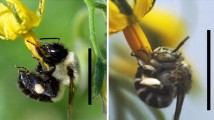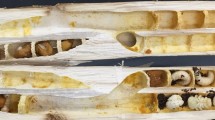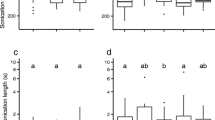Abstract
Bees produce vibrations in many contexts, including for defense and while foraging. Buzz pollination is a unique foraging behavior in which bees vibrate the anthers of flowers to eject pollen which is then collected and used as food. The relationships between buzzing properties and pollen release are well understood, but it is less clear to what extent buzzing vibrations vary among species, even though such information is crucial to understanding the functional relationships between bees and buzz-pollinated plants. Our goals in this study were (1) to examine whether pollination buzzes differ from those produced during defense, (2) to evaluate the similarity of buzzes between different species of bumblebees (Bombus spp.), and (3) to determine if body size affects the expression of buzzing properties. We found that relative peak amplitude, peak frequency, and duration were significantly different between species, but only relative peak amplitude differed between pollination and defensive buzzes. There were significant interactions between species and buzz type for peak frequency and duration, revealing that species differed in their patterns of expression in these buzz properties depending on the context. The only parameter affected by body size was duration, with larger bees producing shorter buzzes. Our findings suggest that although pollination and defensive buzzes differ in some properties, variability in buzz structure also exhibits a marked species-specific component. Species differences in pollination buzzes may have important implications for foraging preferences in bumblebees, especially if bees select flowers best matched to release pollen for their specific buzzing characteristics.


Similar content being viewed by others
References
Arceo-Gómez G, Martinez ML, Parra-Tabla V, Garcıa-Franco JG (2011) Anther and stigma morphology in mirror-image flowers of Chamaecrista chamaecristoides (Fabaceae): implications for buzz pollination. Plant Biol 13(Suppl 1):19–24
Bates D, Maechler M, Bolker B and Walker S (2013). Lme4: linear mixed-effects models using Eigen and S4. R package version 1.0-5. http://CRAN.R-project.org/package=lme4. 1 Nov 2013
Buchmann SL (1983) Buzz pollination in angiosperms. In: Jones CE, Little RJ (eds) Handbook of experimental pollination biology. van Nostrand Reinhold Company, New York, pp 73–113
Buchmann SL, Hurley JP (1978) Biophysical model for buzz pollination in angiosperms. J Theor Biol 72(4):639–657
Cane JH, Buchmann SL (1989) Novel pollen-harvesting behavior by the bee Protandrena mexicanorum (Hymenoptera, Andrenidae). J Insect Behav 2(3):431–436
Corbet SA, Chapman H, Saville N (1988) Vibratory pollen collection and flower form: bumble-bees on Actinidia, Symphytum, Borago and Polygonatum. Funct Ecol 2:147–155
De Luca PA, Bussière LF, Souto-Vilaros D, Goulson D, Mason AC, Vallejo-Marín M (2013) Variability in bumblebee pollination buzzes affects the quantity of pollen released from flowers. Oecologia 172:805–816. doi:10.1007/s00442-012-2535-1
De Luca PA, Vallejo-Marín M (2013) What’s the ‘buzz’ about? The ecology and evolutionary significance of buzz-pollination. Curr Opin Plant Biol 16(4):429–435
Dulberger R, Smith MB, Bawa KS (1994) The stigmatic orifice in Cassia, Senna, and Chamaecrista (Caesalpinaceae): morphological variation, function during pollination, and possible adaptive significance. Am J Bot 81:1390–1396
Evans CS (1997) Referential signals. In: Owings DH, Beacher MD, Thompson MS (eds) Perspectives in ethology. Plenum, New York, pp 99–143
Fidalgo AO, Kleinert AMP (2009) Reproductive biology of six Brazilian Myrtaceae: is there a syndrome associated with buzz-pollination? N Z J Bot 47:355–365
Fox J and Weisberg S (2010). An R companion to applied regression. Sage. http://CRAN.R-project.org/package=car. 1 Nov 2013
Goulson D (2010) Bumblebees: behaviour, ecology, and conservation, 2nd edn. Oxford University Press, New York
Goulson D, Peat J, Stout JC, Tucker J, Darvill B, Derwent LC, Hughes WOH (2002) Can alloethism in workers of the bumblebee Bombus terrestris be explained in terms of foraging efficiency? Anim Behav 64:123–130
Guilford T, Dawkins MS (1991) Receiver psychology and the evolution of animal signals. Anim Behav 42:1–14
Harder LD (1990) Behavioral responses by bumble bees to variation in pollen availability. Oecologia 85:41–47
Harder LD, Barclay MR (1994) The functional significance of poricial anthers and buzz pollination: controlled pollen removal from Dodecatheon. Funct Ecol 8:509–517
Heinrich B (1974) Thermoregulation in bumblebees. I. Brood incubation by Bombus terricola queens. J Comput Phys 88:129–140
Hrncir M, Barth FG, Tautz J (2006) Vibratory and airborne-sound signals in bee communication (Hymenoptera). In: Claridge MF, Drosopoulos S (eds) Insect sounds and communication: physiology, behaviour, ecology and evolution. CRC, Boca Raton, pp 421–436
Jesson LK, Kang J, Wagner SL, Barrett SCH, Dengler NG (2003) The development of enantiostyly. Am J Bot 90(2):183–195
Kawai Y, Kudo G (2009) Effectiveness of buzz pollination in Pedicularis chamissonis: significance of multiple visits by bumblebees. Ecol Res 24:215–223
King MJ (1993) Buzz foraging mechanism in bumble bees. J Apic Res 32(1):41–49
King MJ, Buchmann SL (1995) Bumble bee-initiated vibration release mechanism of Rhododendron pollen. Am J Bot 82:1407–1411
King MJ, Buchmann SL (1996) Sonication dispensing of pollen from Solanum laciniatum flowers. Funct Ecol 10:449–456
King MJ, Buchmann SL (2003) Floral sonication by bees: mesosomal vibration by Bombus and Xylocopa, but not Apis (Hymenoptera: Apidae), ejects pollen from poricidal anthers. J Kans Entomol Soc 76(2):295–305
King MJ, Buchmann SL, Spangler HG (1996) Activity of asynchronous flight muscle from two bee families during sonication (buzzing). J Exp Biol 199:2317–2321
Knudsen JT, Olesen JM (1993) Buzz-pollination and patterns in sexual traits in North European Pyrolaceae. Am J Bot 80:900–913
Larson BM, Barrett SCH (1999) The pollination ecology of buzz-pollinated Rhexia virginica (Melastomataceae). Am J Bot 86(4):502–511
Laverty TM (1980) The flower-visiting behaviour of bumble bees: floral complexity and learning. Can J Zool 58:1324–1335
Luo Z, Zhang D, Renner SS (2008) Why two kinds of stamens in buzz-pollinated flowers? Experimental support for Darwin’s division-of-labour hypothesis. Funct Ecol 22:794–800
Lye GC, Osborne JL, Park KJ, Goulson D (2012) Using citizen science to monitor Bombus populations in the UK: nesting ecology and relative abundance in the urban environment. J Insect Conserv 16(5):697–707
Macior LW (1964) Experimental study of floral ecology of Dodecatheon meadia. Am J Bot 51(1):96–108
Macior LW (1974) Behavioral aspects of coadaptations between flowers and insect pollinators. Ann Miss Bot Gard 61(3):760–769
Michener CD (2000) The bees of the world. Johns Hopkins University Press, Baltimore
Nunes-Silva P, Hnrcir M, Shipp L, Imperatriz-Fonseca VL, Kevan PG (2013) The behaviour of Bombus impatiens (Apidae, Bombini) on tomato (Lycopersicon esculentum Mill., Solanaceae) flowers: pollination and reward perception. J Poll Ecol 11:33–40
Peat J, Tucker J, Goulson D (2005) Does intraspecific size variation in bumblebees allow colonies to efficiently exploit different flowers? Ecol Entomol 30:176–181
Pouvreau A (1989) Contribution à l’étude du polyéthisme chez les bourdons, Bombus Latr. (Hymenoptera, Apidae). Apidologie 20:229–244
Core Development Team R (2010) R: a language and environment for statistical computing. R Foundation for Statistical Computing, Vienna
Russell V (2013). Ls means: least-squares means. R package version 1.10-4. http://CRAN.R-project.org/package=lsmeans. 1 Nov 2013
Vallejo-Marín M, Da Silva EM, Sargent RD, Barrett SCH (2010) Trait correlates and functional signficance of heteranthery in flowering plants. New Phytol 188:418–425
Vallejo-Marín M, Manson JS, Thomson JD, Barrett SCH (2009) Division of labour within flowers: heteranthery, a floral strategy to reconcile contrasting pollen fates. J Evol Biol 22(4):828–839
Acknowledgments
We thank K. Brochu and G. Lye for the helpful comments on earlier drafts of this manuscript and for providing bumblebee advice. This research was supported by a Royal Society of London Research Grant (RG2010R1) and a Scottish Plant Health License (PH/29/2012) to MVM.
Ethical standards
The experiments performed here comply with the current laws of the University of Stirling and the UK.
Author information
Authors and Affiliations
Corresponding author
Additional information
Communicated by: Sven Thatje
Rights and permissions
About this article
Cite this article
De Luca, P.A., Cox, D.A. & Vallejo-Marín, M. Comparison of pollination and defensive buzzes in bumblebees indicates species-specific and context-dependent vibrations. Naturwissenschaften 101, 331–338 (2014). https://doi.org/10.1007/s00114-014-1161-7
Received:
Revised:
Accepted:
Published:
Issue Date:
DOI: https://doi.org/10.1007/s00114-014-1161-7




